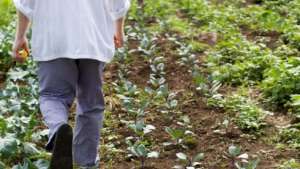From the Series
First Published in

In a world of iPads, electric cars and online social networks, it’s almost quaint to remember that for centuries some of humanity’s most revolutionary innovations have been around the growing, processing and transporting of our food. However, as the population increases, food insecurity grows and incidents of contamination become more frequent, it’s time to get innovative about agriculture again.
Africa is one of the most promising and challenging continents to make this happen. It is relatively underpopulated, and have soils and genetic resources that have not been fully exploited yet. But it also has issues.
There are the big problems: Millions of acres of farmland throughout Africa are leased to foreign investors, usually to grow crops for their own populations in heavily urbanised or desert countries, such as South Korea and the United Arab Emirates. Meanwhile, there is famine in the Horn of Africa.
However, if the number-one priority is feeding Africans, then there are also the practical, farm-scale problems: Preserving seeds and the genetic diversity they hold; tapping water in water-scarce environments; replenishing soils; educating farmers about disease; getting products to market; diversifying rural livelihoods; and reducing waste and spoilage.
Nonetheless, there is exciting innovation in designing new approaches, systems and products to help African farmers feed the continent, while lifting themselves out of poverty. As sustainability and architecture specialist Janis Birkeland has said: “Sustainability is a design problem.”
SMS market info
Farmers are typically located far from most information resources and infrastructure. Across Africa, but particularly in East African countries such as Kenya, farmers are increasingly able to receive SMSes with valuable information such as crop prices and demand, weather patterns, and the location of seeds and fertilisers.
In the past, farmers would travel great distances to market on harvest day and then take what they could get for their crops. These SMS services allow farmers greater control over where, when and how they sell their produce. Esoko, a relatively new service in the West African country of Ghana, claims 20 to 40% improvements in the revenue of farmers accessing the information.
Bamboo bikes
Small-scale African farmers tend to follow a subsistence model, which leaves them vulnerable to economic shocks. Developing new products using agricultural products can help farmers diversify their livelihoods.
Scientists from the Earth Institute at Columbia University worked with a Ghanaian company to develop a bicycle with a bamboo body. Bamboo is quick growing and remarkably flexible and strong. Light and tough, the Bamboo Bike is well-suited to rural conditions, but there has been so much interest in it internationally that 80% of production is now for overseas markets.
Purchase for profit
Food aid is regularly criticised as being little more than the dumping of agricultural surpluses from developed countries, often with detrimental effects on those local markets already struggling to survive. The World Food Programme’s “Purchase for Profit” initiative links farmers to markets by pooling relief food locally instead of importing it, stimulating the economy in the devastated area and supporting the livelihoods of small-scale farmers.
Appropriate technologies
Spoilage is a big problem for African farmers, who are usually far from warehousing facilities and processing plants. Cheap, simple technologies, such as groundnut grinders, can reduce the amount of labour required to get produce into a storable form and allow small farmers to increase their income, creating products that they can sell to others in the community.
Energy from farming
Wood is the main source of energy for rural communities, making managing natural forest depletion a challenge. But there are ways to harness agriculture for more sustainable biomass production. One way is through adjusting farming methods to hark back to traditional approaches.
For example, the Food and Agriculture Organisation recommends an Integrated Food Energy System: Either agroforestry, where food and energy crops are grown on the same plot of land; or educating farmers on how to use by-products of their farm (such as manure and crop residue) to generate energy. Another way is through using new, smart technologies: Imported machinery that compresses waste biomass into briquettes is also widely used, and locally-built machines are being piloted in countries like South Africa.
Comic education
Not all Africans can receive formal education in agriculture and therefore won’t receive information on new techniques that can help them be more successful. Kenyans can learn about sustainable approaches to farming – such as inoculating chickens against disease, fruit drying and seed protection – through the ShujaazFM (meaning “Heroes”) comic carried in the Saturday Nation newspaper, reaching 12 million people a month.
“Lost” crops of Africa
Farmers have interbred plants and animals to bring out their best characteristics for centuries, turning inedible grass into super crop maize, for example. But in the process, genetic diversity – and the ability to adapt to shifts like climate change – has been lost.
Africa, however, hasn’t bred out all its options, which is why institutes like the Grow Biointensive Agriculture Centre of Kenya (G-BIACK) are so important. They preserve genetic diversity and encourage African farmers to exchange successful heirloom seeds beyond their immediate families.
Desperate farmers can easily be taken in by companies selling genetically modified seeds that have higher yields but do not regenerate, when they should rather be sharing the indigenous crops that perform best within the community. As a continent, Africa must remain aware that in the future, when the metals and oil run out, its biodiversity will be its strength.
Solar drip irrigation
Drip irrigation – piping that delivers small amounts of water to the roots of plants using gravity via networks of plastic tubing – is one of the most efficient ways of saving water and improving yields. In Africa, it can also free-up labour on small-scale farms, as water no longer has to be collected by hand. However, these systems need some energy input to run and most rural farmers are off the grid. Solar-powered drip irrigation systems installed in Benin have been shown to increase yields, improving the vegetable intake by the families of subsistence farmers who grow plants for household use by 500g to 750g per day.
A drawback of solar is upkeep and potential theft. Simple, locally made devices that can be fixed by the farmers themselves are good solutions too. An example is a foot-powered treadle-pump, manufactured in Zambia and developed by IDE, an international social enterprise using design to solve developmental problems.
Southern Agricultural Growth Corridor
Design is not always about creating a product, but a system. In Africa, one of the challenges is a lack of coordination between regions, resulting in stifled trade. Tanzania’s new Southern African Growth Corridor is a public-private partnership that looks to link clusters of smallholder farmers with the resources to improve their farming practices and get their produce to market. This allows them to make money off surpluses, and invest in their families and farms.
Michelle Matthews is a one-time-publisher turned sustainability consultant who serves up legendary spreads in her dining room. Her Whole Food Almanac was published in 2009. Website: www.michellematthews.co.za. Twitter: @michelle_matt.








